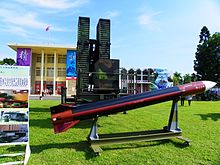
The Sky Bow, or Tien Kung (Chinese: 天弓; pinyin: Tiān gōng), are a series of surface-to-air anti-ballistic missile and anti-aircraft defense systems developed by Taiwan. The TK-2 and TK-3 are in service with the Military of the Republic of China.
Development
Research into what became the Sky Bow project began after the United States ended bilateral relations with the Republic of China in 1979. Other names proposed by engineer Chen Chuan-hao for the project included Sky Horse (Pegasus) and Flying Horse. Upon formal approval of the project in October 1980, it became known as Sky Bow. The development of the Sky Bow 1 (Tien Kung 1) missile system was started in 1981 by the National Chung-Shan Institute of Science and Technology (then CSIST). But it was not until 1984 that Taiwan gained the cooperation of Raytheon and was allowed to examine semi-obsolete missiles in detail. CSIST experts traveled to the United States studied the technology, but they were not allowed to ask any questions and quickly came to the conclusion that many of the missiles they had been allowed to examine were old and had been damaged while in storage.
Firing trials started in 1986, using a semi-active radar homing seeker. A passive infrared homing terminal seeker was also developed as a secondary seeker for the TK-1, this was successfully tested against a HAWK missile target but was never put into production. CSIST also developed a large multifunction, phased-array radar known as Chang Bai (long white) for use with the Tien Kung (Sky Bow) series surface-to-air missile systems with 120 degree coverage and a maximum range of 450 km. Two versions of the phased array radar exist, a towed trailer radar and fixed "hardened" radar sites.
The Chang Bai radar system is reported to be based on the Lockheed Martin's ADAR-HP (Air Defense Array Radar-High Power) design and operates in the 2–4 GHz range (S-band). At least seven systems were said to be in service in 2006. The system performance specifications remain classified, but its effective detection range against a 1m target is reported to be around 400 km.
There was also a mobile version of the phased array radar developed in the late 1990s which could provide all-round radar cover with four separate faces but with a much decreased detection range. This version only appeared in public once but was never put into service. The development of Sky Bow 2 started around 1986, this added a tandem boost motor and an active radar homing terminal seeker. Proposals were reported to develop Sky Bow 2 into a surface-to-surface missile; unconfirmed reports suggest that this missile is known as Tien Chi. Modifications have been developed for Sky Bow 2, changing it into a single-stage rocket and to provide it with a limited capability against shorter-range ballistic missiles; the first test firing against a ballistic missile target was reported in September 2008. Seven batteries were in service in 2006. In 2010 TK-1/2 SAMs were in service and deployed throughout Taiwan, on the Pescadores, and Dong Ying island.
Sky Bow I
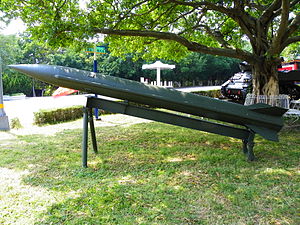
The Sky Bow I (TK-1) (天弓一, Tien Kung I) is a surface-to-air missile (SAM) system developed by the Chungshan Institute of Science and Technology (CSIST) in Taiwan. Originally based on the aerodynamics of the MIM-23 Hawk missile, the original missile design resembled a scaled-up Raytheon AIM-54 Phoenix. The TK-1 missile was subsequently redesigned and eventually became very similar in appearance to the US Patriot missile after the US government allowed Raytheon to transfer 85 percent of the MIM-104 Patriot missile technology. There is no track-via-missile (TVM) homing capability as this technology was not included in the technology package licensed to Taiwan; the TK-1 system operates in a similar manner to the US Standard SM2 missile, requiring an illuminating radar during the terminal phase.
The TK-1 is designed primarily to target low and medium altitude attacks. Each TK-1 battery has one Change Bai 1 (Long White 1) S-Band phased-array radar for search and target tracking and two CS/MPG-25 target illuminator radars that operates in the X-Band (18–32 GHz) range for the terminal phase, servicing three or four 4-round missile launchers. The combination of inertial/autopilot and mid-course command guidance with a terminal semi-active radar seeker allows the TK-1 missile to fly an energy-efficient flight path to the vicinity of the target where the seeker's semi-active radar would then receive target illumination for the final seconds of the engagement, giving the target minimum amount of time either to evade or commence electronic countermeasure (ECM).
Two versions of the missile launcher exist, one is housed in underground shelters designed to survive an intensive attack. The other is a towed mobile version, and is an integral part of Taiwan's dense air defense network. In addition to bases on Taiwan proper, the TK-1 has also been deployed by the ROC Army on the outlying islands of Penghu and Dong Ying, bringing all of the Taiwan Strait and parts of the PRC's Fujian, Zhejiang and Guangdong Provinces within range.
It was reported in Jane's Missiles and Rockets, August 2006's issue, that the Tien Kung 1 surface-to-air missile (SAM) system would be retired. The TK-1 missiles would be replaced with TK-2 missile rounds and the existing TK-1 system would be upgraded with radar and training simulator to the Tien Kung II standard.
CS/MPG-25 target illuminator radars
The CS/MPG-25 X-band target illuminator radar entered service in the late 1980s. It has a reported maximum range of 222km and a ceiling of 30,480m. The CS/MPG-25 is a continuous wave disk antenna illuminator radar that was indigenously developed by CSIST, and was derived from the I-HAWK AN/MPQ-46 High-Power Illuminator (HPI) radar but is estimated to be 60 percent more powerful in output with improved EW, ECM, and IFF capabilities. It is tied into the main phased-array radar on a time-share basis similar to that employ by the US Navy's AEGIS air defence system, allowing the TK-1 surface-to-air missile system multiple target engagement capability.
General characteristics
- Primary Function: surface-to-air missile
- Power Plant: Single-stage dual-thrust solid-fuel rocket motor
- Launch platform: Towed quad launchers and underground silos
- Length: 5.3 m
- Diameter: 0.41 m
- Weight: 915 kg
- Top Speed: Mach 4.0
- Range: 70 km
- Guidance: Inertial with mid-course guidance update from ground-based phased array radar, Semi-active radar homing (SARH) for terminal guidance
- Date Deployed: 1986
Sky Bow II

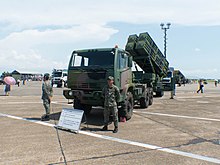
The Sky Bow II (TK-2) (天弓二, Tien Kung II) is a SAM system also developed by the Chungshan Institute of Science and Technology. Originally a TK-1 with a first-stage booster, the system became a slightly-enlarged modified version of the Sky Bow I (TK-1) missile using an X-Band active-radar seeker, with a longer range and limited anti-missile capability. The TK-2 active radar seeker operates in the 28–32 GHz frequency range and provides reasonably good performance against air-breathing targets of typical aircraft size. The X-Band active radar seeker used on the TK-2 SAM system was developed from licensed radar technology that CSIST purchased from the U.S. in the 1980s. The system uses the improved Change Bai 2 (Long White 2) multifunction radar which entered service in the late 1990s. The first public test of the TK-2, codenamed Magic Arrow 43, occurred on May 10, 2002 during the Han kuang 18 exercise.
The TK-2 also has the added benefit of being able to use the same box launcher as the TK-1. Internal components were replaced with miniaturized parts to take advantage of modern electronics technologies, yielding extra room within the missile for more fuel and a more powerful main rocket motor. The TK-2 possesses only modest capabilities against ballistic missiles but is highly effective against aircraft.
Variants

The TK-2 has been modified into the Sky Spear short-range ballistic missile. The TK-2 has also been modified for use as a sounding rocket to perform upper atmospheric research for the civilian space program. The sounding rocket test vehicle launched on December 24, 2003, measures 7.7m in overall length and 1,680 kg in launch weight. It reached a maximum altitude of almost 270 km and splashed 142 km down range around 8 minutes after launch into the Pacific. The science mission payload was in the 220 pounds (100 kg) weight class and the rocket reached a burnout velocity of 2,000 m/s. According to the report from Taiwan Defense Review, depending on its payload and launch parameters, the rocket can be converted to attain a horizontal maximum range of up to 500 km. According to the Taipei Times retired president of NCSIST Kung Chia-cheng claimed that two variants were developed, one with a range of 600km and the other with a 1000km+ range.
General characteristics
- Primary Function: surface-to-air missile
- Power Plant: Single-stage dual-thrust solid-fuel rocket motor
- Launch platform: Underground silos
- Length: 5.673 m
- Diameter: 0.42 m
- Weight: 1,135 kg
- Top Speed: Mach 4.5
- Warhead: 90 kg
- Range: 150 km
- Guidance: Inertial with mid-course guidance update from ground-based phased array radar, Active radar homing (ARH) for terminal guidance
- Date Deployed: 1997
Sky Bow III
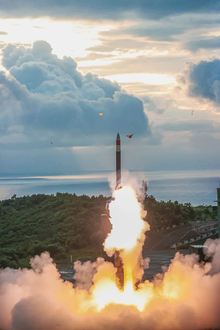

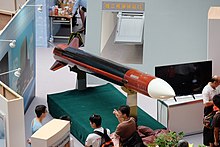
Sky Bow III (TK-3) (天弓三, Tien Kung III) is the third generation of the missile system. Taiwan had initially sought and even proposed a joint development effort to co-produced a missile defense interceptor with the U.S. Taiwan officials asked for U.S. technical support for Taiwan's indigenous anti-tactical ballistic missile (ATBM) effort, including the transfer of Hit-to-Kill (HTK) technologies, specifically those related to an active radar Ka-band seeker and precision attitude control. CSIST was reported to had sought the release of the associated traveling-wave tube (TWT) transmitter of the Ka-band active radar seeker technology. However, U.S. refusal of the export release of a complete Ka-band active radar seeker without tamper protection or to provide the TWT on a stand-alone basis forced CSIST to use a different active radar seeker technology with a little European content.
The TK-3 (formerly known as TK-2 ATBM) was conceived as a lower-tier missile defense system based on the TK-2 missile that uses an imported Ku-Band (12–18 GHz) active radar seeker, a directed fragmentation warhead, and improved precision controls for engaging high-speed, low radar cross-section (RCS) targets such as tactical ballistic missiles. It is designed with greater mobility in mind than the original TK-1/2 systems, with an integrated battle management system, and uses an upgraded Chang Bai phased array radar or with the new mobile phased-array radar that is reportedly called the Mobile 3-Dimensional (3D) Air Defense Fire Control Phased Array Radar (Mobile 3D ADFCPAR).
The new mobile radar reportedly called Chang-Shan ("Long Mountain") radar system, like the Patriot's Raytheon AN/MPQ-65 radar system, is reported to operate on the C-Band (4–8 GHz) frequency range, and like the AN/MPQ-65 system, it is trailer-mounted with a rectangular planar array radar of approximately similar size. However, it does not appear to have any identifiable missile guidance sub-array like those found below the main array on the AN/MPQ-65 system and it is therefore not clear if this new radar can provide target guidance illumination function in support of TK-1 SARH missiles. However, this should not present any problem for the new radar to be utilized on both TK-2 missile (X-Band) and TK-3 missile (Ku-Band) active radar seekers, as these missile systems do not require target illumination. The new radar enhances the survivability and operational flexibility of the TK2/3 missile systems by allowing a TK surface-air-missile battery to be deployed rapidly to a previously unprepared site. The TK-3 incorporates advanced ceramics and carbon fiber in its construction. The missile's nose cone can resist temperatures in excess of 1,000 °C. The TK-3 is capable of both midcourse and terminal defense against ballistic missiles.
Production of the Tien Kung 3 SAM commenced in 2014 with an initial production run of 12 batteries. With the retirement of the HAWK batteries and the Sky Bow II becoming more obsolete, another twelve batteries of Sky Bow IIIs were ordered to replace these older systems. Conversion of six older batteries to Sky Bow IIIs began in 2022 and is to be completed by 2025. Work on the remaining six batteries began in early 2023 and is to be completed by 2026. Previously, the United States had given Taiwan the options of upgrading the Hawk, buying the NASAMS system, and/or buying the THAAD missile system to replace their Hawks. The Ministry of National Defense ultimately decided to pursue the development of indigenous weapons to meet the need.
In 2019 Taiwanese President Tsai Ing-wen ordered the NCSIST to accelerate mass production of the TK-3 in response to increasing Chinese military power and bellicosity. In response to President Tsai’s request NCSIST completed their quota for TK-3 missile production ahead of schedule in 2021.
In 2023 the Taiwanese MOD announced plans to build twelve new bases to host TK-3 batteries, six expected to complete before the end of 2025 and six more expected to complete before the end of 2026.
Variants
In late 2016, NCSIST launched a ship-based variant of the Sky Bow III BMD interceptor. According to NCSIST, the test was conducted from a land-based launcher and "was successful and the data was satisfactory". The ship-based version has a folding tail to fit in Mark 41 vertical launch systems and is planned to be deployed on the ROCN's next-generation general-purpose frigates and air defense destroyers as well as possibly retrofitted onto existing vessels.
General characteristics
- Primary Function: surface-to-air missile
- Power Plant: Solid-fuel rocket motor
- Launch platform: Towed quad launchers
- Length: 5.498 m
- Diameter: 0.4 m
- Weight: 870 kg
- Top Speed: Mach 7.0
- Range: 200 km
Export
The TK-3 has seen interest from foreign buyers but as of November 2019 none were confirmed.
Strong Bow I
In 2023 development work on a new BMD missile, dubbed Strong Bow, with a maximum interception altitude of 70km was completed. While often reported as an extended range variant of the TK-3, the Strong Bow is a distinct missile. Differences from the TK-3 include the fuselage, nosecone, and propulsion system. It also has a domestically produced microwave power amplifier and a Ka band seeker.
Strong Bow II
A longer ranged variant of the Strong Bow I with an intercept altitude of 100km or more is in development.
See also
- Sky Spear – (Taiwan)
- Sky Sword I/Antelope air defence system/Sea Oryx – (Taiwan)
- MIM-104 Patriot – (United States)
- Aster_(missile_family) – (France, Italy)
- Sayyad-2 – (Iran)
- KN-06 – (North Korea)
- KM-SAM – (South Korea)
- L-SAM – (South Korea)
- HQ-9 – (China)
- S-300 missile system – (Soviet Union, Russia)
- Defense industry of Taiwan
- Comparison of anti-ballistic missile systems
References
Notes
- Everington, Keoni (2016-12-15). "Taiwan test fires Sky Bow air defense missiles amid tensions with Beijing". Taiwan News. Archived from the original on 2017-02-11. Retrieved 2017-02-10.
- Han Cheung (29 October 2023). "Taiwan in Time: The homegrown 'sky bow' project". Taipei Times. Retrieved 29 October 2023.
- ^ Strong, Matthew (27 November 2019). "Foreign arms buyers show interest in Taiwan's Sky Bow III missile". www.taiwannews.com.tw. Taiwan News. Archived from the original on 3 December 2019. Retrieved 3 December 2019.
- ^ Mei, Fu S. "Medium Range Air Defense Radar," Taiwan Defense Review, June 19, 2006.
- ^ "Tien Kung Weapon System" Archived 2011-07-22 at the Wayback Machine Chungshan Institute of Science and Technology
- Mei, Fu S. "Taiwan Tests TK-2A ATBM," Taiwan Defense Review, September 18, 1998.
- "The Balance of Air Power in the Taiwan Strait" Archived 2011-09-28 at the Wayback Machine US-Taiwan Business Council, May 2010.
- ^ O'Halloran, James C. "Tien Kung I low-to-medium-altitude surface-to-air-missile system, pages 299-300," Jane's Land-Based Air Defense, 2002-2003 Edition.
- Richardson, Doug "Taiwan switches from Tien Kung I to Tien Kung II," Jane's Missiles and Rockets, August, 2006.
- "CS/MPG-25 (Sky Bow Illuminator)". cmano-db.com. CMANO. Archived from the original on 1 August 2019. Retrieved 1 August 2019.
- ^ Mei, Fu S. "CSIST Seeks New Seeker," Taiwan Defense Review, January 15, 2002.
- "Long White 2 (Sky Bow 2 MFR)". cmano-db.com. CMANO. Archived from the original on 1 August 2019. Retrieved 1 August 2019.
- ^ "Taiwan: U.S. Ties Squeeze Missile Development". worldview.stratfor.com. STRATFOR. Archived from the original on 9 August 2019. Retrieved 8 August 2019.
- ^ Mei, Fu S. "Taiwan Forming Missile Command," Taiwan Defense Review, February 16, 2004.
- Chern, Jeng-Shing; Wu, Bill; Chen, Yen-Sen; Wu, An-Ming (2012). "Suborbital and low-thermospheric experiments using sounding rockets in Taiwan". Acta Astronautica. 70: 159–164. doi:10.1016/j.actaastro.2011.07.030. ISSN 0094-5765.
- ^ Mei, Fu S. "Satellite Prospects," Taiwan Defense Review, October 20, 2004.
- Tien-pin, Lo; Hetherington, William. "New missiles can travel 2,000km: source". taipeitimes.com. Taipei Times. Retrieved 16 November 2023.
- ^ Fu S. Mei. "More Sounding Rocket Missions," Taiwan Defense Review, February 11, 2003.
- ^ O'Halloran, James C. "Tien Kung II, pages 298-299," Jane's Land-Based Air Defense, 2002-2003 Edition.
- Stokes, Mark A. "Taiwan's Security - Beyond the Special Budget," Archived 2011-04-26 at the Wayback Machine American Enterprise Institute for Public Policy Research, March 2006.
- ^ Mei, Fu S. "Retaining Missile Defense Focus," Taiwan Defense Review, March 27, 2006.
- Minnick, Wendell "Taiwan Proceeds on LACM," Defense News, September 15, 2008.
- Freeman, Cameron (December 2019). "China's Next Generation Missile: The DF-17 in Pacific Conflict and Great Power Competition" (PDF). Institute for National Defense and Security Research. 8 (4): 35–54. Archived (PDF) from the original on 31 May 2021. Retrieved 17 February 2020.
- 呂, 昭隆 (December 3, 2014). "國軍將採購12套天弓三飛彈". 中國時報. Archived from the original on May 28, 2022. Retrieved December 20, 2023.
- "DEFENSE/Taiwan to build 12 new domestic TK III missile sites by 2026". Focus Taiwan CNA News. October 23, 2023. Archived from the original on November 2, 2023. Retrieved December 20, 2023.
- Taiwan Retires Hawk Missiles - Defensenews.com, 15 September 2014
- Wen Kuei-hsiang and, FLor Wang. "Taiwan president urges faster mass production of missiles". focustaiwan.tw. Focus Taiwan. Archived from the original on 18 May 2019. Retrieved 18 May 2019.
- Chen, Kelvin (31 March 2021). "Sky Bow III missiles completed ahead of schedule: Taiwan's defense ministry". www.taiwannews.com.tw. Taiwan News. Archived from the original on 31 March 2021. Retrieved 30 May 2021.
- Strong, Matthew. "Taiwan to station Sky Bow III missiles at 12 new bases". taiwannews.com.tw. Taiwan News. Retrieved 29 April 2024.
- Taiwan's NCSIST Successfully Tested a Ship-based Variant of Tien Kung III BMD Interceptor Archived 2017-01-03 at the Wayback Machine - Navyrecognition.com, 2 January 2017
- and Liao Yen-Fan, Michal Thim (25 March 2016). "Taiwan Navy Emphasizing Domestic Shipbuilding Program in Ongoing Maritime Restructure". news.usni.org. USNI. Archived from the original on 3 December 2019. Retrieved 3 December 2019.
- "tw.news". 6 December 2018. Archived from the original on 2019-04-17. Retrieved 2019-04-17.
- "Tien-Kung III (Sky Bow III) Surface-to-Air Missile System". Archived from the original on 2019-04-17. Retrieved 2019-04-17.
- 朱, 明 (September 10, 2018). "【獨家】攔截軍機繞台及東風21型飛彈 弓三增程型飛彈完成驗證提早部署". 上報. Archived from the original on May 28, 2022. Retrieved August 30, 2023.
- ^ Lo, Tien-pin; Hetherington, William. "New missile bolsters air defense: MND". Taipei Times. Retrieved 28 April 2023.
External links
- Sky Bow I article on GlobalSecurity
- Sky Bow II article on GlobalSecurity
- Manufactures' videos
| Republic of China Air Force | ||
|---|---|---|
| Structure |
| |
| Facilities | ||
| Aircraft | ||
| History | ||
| Equipment | ||
| National Chung-Shan Institute of Science and Technology (NCSIST) aircraft | |
|---|---|
| Fixed-wing aircraft | |
| Missiles | |
| Radars | |